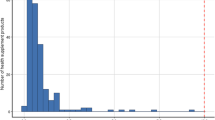Abstract
Complementary and alternative medications, including the use of herbal medications, have become quite popular in the USA. Yerberias are found throughout the southwest and specialize in selling Hispanic herbal products. The products sold in these stores are not regulated by any governmental agency. Previous reports have found Ayurvedic medications contain high levels of lead, mercury, and arsenic. The primary purpose of this study is to examine the prevalence of heavy metal contaminants sold at Yerberia stores in the southwest. Yerberias in the Phoenix, Arizona area were identified via search of an on-line search engine using the words "Yerberia Phoenix." Every second store was selected, and products were purchased using a standard script. The products were subsequently analyzed for mercury, lead, and arsenic. The main outcome is the prevalence of heavy metal content in over-the-counter "cold" medications purchased at a Yerberia. Twenty-two samples were purchased. One product contained pure camphor (2-camphone) and was subsequently not further analyzed. Of the 21 samples analyzed, lead was found in 4/21 (19.4 %). Arsenic and mercury were in 1/21 (4.8 %) each. Because two samples contained two heavy metals, the total prevalence of heavy metals was 4/21 (19.4). Heavy metal contaminants are commonly encountered in over-the-counter herbal "cold" medications purchased at Yerberias in the southwest.
Similar content being viewed by others
References
Barnes PM, Bloom B, Nahin R (2008) Complementary and alternative medicine use among adults and children: United States, 2007. National Health Statistics reports; no 12. Hyattsville, MD. National Center for Health Statistics
Saper RB, Kales SN, Paquin J et al (2004) Heavy metal content of ayurvedic herbal medicine products. JAMA 292:2868–2873
Saper RB, Phillips RS, Sehgal A et al (2008) Lead, mercury, and arsenic in US- and Indian manufactured ayurvedic medicines sold via the internet. JAMA 300:915–923
Garvey GJ, Hahn G, Lee RV et al (2001) Heavy metal hazards of Asian traditional remedies. Int J Environ Health Res 11:63–71
Ernst E (2002) Heavy metals in traditional Indian remedies. Eur J Clin Pharmacol 57:891–896
Method 3050 B. Acid digestion of sediments, sludges, and soils. Environmental Protection Agency. http://www.epa.gov/wastes/hazard/testmethods/sw846/pdfs/3050b.pdf. Accessed 23 Oct 2011
Method 200.9, Revision 2.2 (1994) Determination of trace elements by stabilized temperature graphite furnace atomic absorption. Environmental Protection Agency. http://water.epa.gov/scitech/methods/cwa/bioindicators/upload/2007_07_10_methods_method_200_9.pdf. Accessed 23 Oct 2011
Method 7473 (2007) Mercury in solids and solutions by thermal decomposition, amalgamation, and atomic absorption spectrophotometry. http://www.epa.gov/sam/pdfs/EPA-7473.pdf. Accessed 23 Oct 2011
Ottolini MC, Hamburger EK, Loprieato JO et al (2001) Complementary and alternative medicine use among children in the Washington, DC area. Ambul Pediatr 1:122–125
Sidora-Arcoleo K, Yoos HL, Kitzman H et al (2008) Don't ask, don't tell: parental nondisclosure of complementary and alternative medicine and over-the-counter medication use in children's asthma management. J Pediatr Health Care 22:221–229
Yu SM, Ghandour RM, Huang ZJ (2004) Herbal supplement use among US women, 2000. J Am Med Wom Assoc 59:17–24
Heard K, Sloss D, Weber S et al (2006) Overuse of over-the-counter analgesics by emergency department patients. Ann Emerg Med 48:315–318
Khandpur S, Malhotra AK, Bhatia V et al (2008) Chronic arsenic toxicity from Ayurvedic medicines. Int J Dermatol 47:618–621
Dunbabin DW, Tallis GA, Popplewell PY et al (1992) Lead poisoning from Indian herbal medicine (Ayurveda). Med J Aust 157:835–836
Moore C, Adler R (2000) Herbal vitamins: lead toxicity and developmental delay. Pediatrics 106:600–602
Herbal dietary supplements: examples of deceptive or questionable marketing practices and potentially dangerous advice (2010) United States Government Accountability Office. Report GAO-10-662 T. http://www.gao.gov/assets/130/124774.pdf. Accessed 23 Mar 2012.
Codex general standard for contaminants and toxins in foods (1994). http://www.codexalimentarius.net/download/standards/17/CXS_193e.pdf. Accessed 13 Nov 2011.
Conflict of Interest
There are no financial, litigational, or other conflicts of interest involved in the preparation of this manuscript.
Author information
Authors and Affiliations
Corresponding author
Rights and permissions
About this article
Cite this article
Levine, M., Mihalic, J., Ruha, AM. et al. Heavy Metal Contaminants in Yerberia Shop Products. J. Med. Toxicol. 9, 21–24 (2013). https://doi.org/10.1007/s13181-012-0231-5
Published:
Issue Date:
DOI: https://doi.org/10.1007/s13181-012-0231-5




